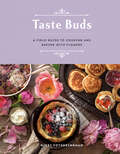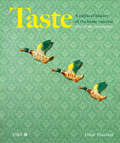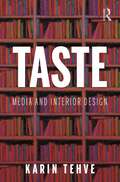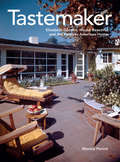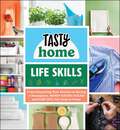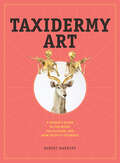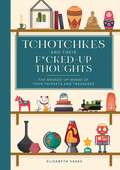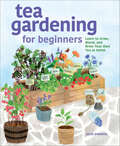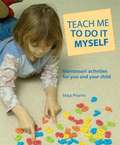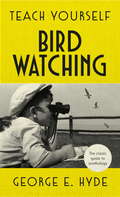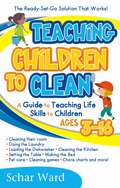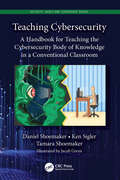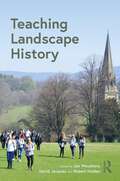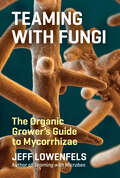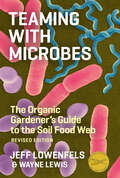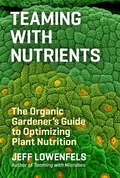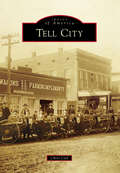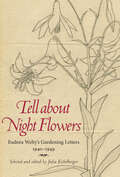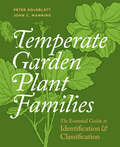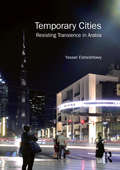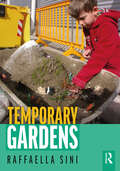- Table View
- List View
Taste Buds: A Field Guide to Cooking and Baking with Flowers
by Nikki FotheringhamAn inviting, beautiful cookbook for everyone who loves flowers. Inside these pages you'll find recipes for meals and drinks of all kinds, using edible flowers in surprising and delightful ways.Many garden-variety flowers are not only lovely to look at, they&’re also unique additions to any meal. Curious to learn how? Just ask Nikki Fotheringham—gardener, home cook, and forager—who grows flowers in the meadow behind her house and turns them into edible products that she sells in her farm store. In Taste Buds, Nikki shares her recipes for baked goods like the Lemon Elderflower Cake, preserves like the Rose Jam (perfect on scones or alongside a charcuterie board), savory dishes like the Flower Pasta with Marigold Pesto, and wildflower drinks like the Lavender Love Martini. Inside, you&’ll find:Over 90 Recipes Featuring Flowers: Each recipe highlights the natural flavors of flowers, all organized in stunning color-coded chapters.A Guide to 15 Flower Varieties: Learn to identify and forage different flowers, from well-known favorites like hibiscus, lavender, peonies, and roses, to unexpected novelties like sumac, cornflowers, cattails, and more.Tips and Tricks for Growing Flowers: Make sure your garden sets you up for success in the kitchen, with plenty of info on how to grow and care for your plants.Whether you&’re an avid gardener, a foodie, or someone who simply adores flowers, you&’re sure to delight in Taste Buds.
Taste of Home: Freezer Pleasers Cookbook
by Taste Of HomeThis collection of 325 recipes gives home cooks everything they need to make the perfect meal and freeze larger batches to be enjoyed throughout the week.
Taste: A cultural history of the home interior
by Drew PlunkettDemocratic in intention and approach, the book will argue that the home interior, as independently created by the ‘amateur’ householder, offers a continuous informal critique of shifting architectural styles (most notably with the advent of Modernism) and the design mainstream. Indeed, it will suggest that the popular increasingly exerts an influence on the professional. Underpinned by academic rigour, but not in thrall to it, above all this book is an engaging attempt to identify the cultural drivers of aesthetic change in the home, extrapolating the wider influence of ‘taste’ to a broad audience – both professional and ‘trade’. In so doing, it will explore enthralling territory – money, class, power and influence. Illustrated with contemporary drawings and cartoons as well as photos, the book will not only be an absorbing read, but an enticing and attractive object in itself.
Taste: Media and Interior Design
by Karin TehveThis book traces and explores the evolution of taste from a design perspective: what it is, how it works, and what it does. Karin Tehve examines taste primarily through its recursive relationship to media. This ongoing process changes the relationship between designers and the public, and our understanding of the relationship of individuals to their social contexts. Through an analysis of taste, design is understood to be an active constituent of social life, not as autonomous from it. This book reclaims a term long dismissed from interior design and unveils taste’s role as a powerful social and political agent within systems of aesthetics, affecting both its producers and consumers. Each chapter discusses a taste concept or definition, analyzes its reciprocal relationship with media, and explores its implications for interior design. Illustrated with 70 images, taste’s relationship to media is viewed through a variety of different lenses, including books, photography, magazines, internet, social media and algorithms. Written primarily for students and scholars of interior design and related design fields, this book will be a helpful resource for all those interested in the question of taste, and is an invitation to produce and consume all media critically.
Tastemaker: Elizabeth Gordon, House Beautiful, and the Postwar American Home
by Monica PenickA riveting and superbly illustrated account of the enigmatic House Beautiful editor’s profound influence on mid-century American taste From 1941 to 1964, House Beautiful magazine’s crusading editor-in-chief Elizabeth Gordon introduced and promoted her vision of “good design” and “better living” to an extensive middle-class American readership. Her innovative magazine-sponsored initiatives, including House Beautiful’s Pace Setter House Program and the Climate Control Project, popularized a “livable” and decidedly American version of postwar modern architecture. Gordon’s devotion to what she called the American Style attracted the attention of Frank Lloyd Wright, who became her ally and collaborator. Gordon’s editorial programs reshaped ideas about American living and, by extension, what consumers bought, what designers made, and what manufacturers brought to market. This incisive assessment of Gordon’s influence as an editor, critic, and arbiter of domestic taste reflects more broadly on the cultures of consumption and identity in postwar America. Nearly 200 images are featured, including work by Ezra Stoller, Maynard Parker, and Julius Shulman. This important book champions an often-neglected source—the consumer magazine—as a key tool for deepening our understanding of mid-century architecture and design.
Tasty Home: From Organizing Your Kitchen to Saving a Houseplant, Money-Saving Hacks and Easy DIYs You Need to Know (Tasty Home Series)
by Tasty HomeDiscover all the life hacks you&’ve been missing with this perfect compendium of skills to answer all of life&’s most asked questions from BuzzFeed&’s popular lifestyle destination Tasty Home. Need help unclogging a drain? Can&’t seem to keep a plant alive? Just want to finally know how to fold a fitted sheet? Let BuzzFeed&’s Tasty Home make your life a whole lot easier. With Tasty Home: Life Skills, you&’ll learn simple tricks, helpful hacks, and super easy DIYs to increase your how-to knowledge. This book teaches you everything you need to know—even things you didn&’t know you needed to know! Based on the most searched topics on Tasty Home&’s site and social channels, this go-to guide covers the kind of questions that would have you calling mom. Now, you can secure your spot as a real-life adult whether you need to fix a kitchen fail or quickly sew on a button, this book has your back. Tasty Home: Life Skills packs all the fun and helpful info of BuzzFeed&’s how-to site into the perfect guide you&’ll find yourself going back to again and again.
Taxidermy Art: A Rogue's Guide to the Work, the Culture, and How to Do It Yourself
by Robert MarburyIn this collection of taxidermy art, you’ll find a winged monkey with a fez and a martini glass, a jewel-encrusted piglet, a bionic fawn, and a polar bear balancing on a floating refrigerator. Author Robert Marbury makes for a friendly (and often funny) guide, addressing the three big questions people have about taxidermy art: What is it all about? Can I see some examples? and How can I make my own? He takes readers through a brief history of taxidermy (and what sets artistic taxidermy apart) and presents stunning pieces from the most influential artists in the field. Rounding out the book are illustrated how-to lessons to get readers started on their own work, with sources for taxidermy materials and resources for the budding taxidermist.
Tchotchkes and their F*cked-Up Thoughts: The Messed-Up Minds of Your Trinkets and Treasures (F*cked-Up Thoughts)
by Elisabeth SaakeDiscover what your favorite trinkets really think of you—in this wickedly funny illustrated gift book."Cheeky, delightful . . . an uproarious gift book that&’s sure to leave all kinds of collectors amused and chagrined."—Foreword Reviews Ever wonder if your ceramic Buddha is silently judging your life choices? Or if your antique compass is dizzy from your lack of direction? In Tchotchkes and Their F*cked-Up Thoughts, your quirky collectibles finally speak their minds—and they are brutally honest. This hilarious and highly giftable book brings together dark humor, colorful art, and a dash of existential dread. Perfect for collectors, design lovers, and fans of sarcastic humor, this is a must-have for anyone with a shelf full of curios and a dark sense of humor. Inside you'll find: • 55 full-color illustrations of inanimate objects with serious emotional baggage • Snarky, witty, and surprisingly insightful one-liners from baubles, trinkets, and bric-à-brac • A perfect companion to the hit humor book Houseplants and Their F*cked-Up Thoughts Whether you&’re looking for a quirky coffee table conversation starter, a white elephant gift, or a way to laugh at your own questionable decor, this book delivers collectible chaos and offbeat charm. Get ready to laugh, cringe, and never look at your tchotchkes the same way again.
Tea Gardening for Beginners: Learn to Grow, Blend, and Brew Your Own Tea at Home
by Julia DimakosA gardening book that's sure to be your cup of tea What's more satisfying than brewing the perfect cup of tea? Brewing it from tea you grew yourself! Create your own tea garden with help from this beginner's guide. It walks you through every step of the process, from planning your garden plot to preparing delicious tea blends.Know your teas—Become a true devotea as you explore different types of teas and tisanes, along with the best ways to blend and brew them.Build your garden—Learn how to choose the best location for your garden, the essential tools you should have on hand, and the proper techniques for pruning and harvesting.Dig into plant profiles—From lavender to lemongrass, read quick rundowns of 25 different plants, including their taste profiles, safety considerations, and preservation techniques.Grow the skills you need to make your own tea blends for increased energy, relaxation, digestion, and just plain enjoyment with Tea Gardening for Beginners.
Teach Me to Do It Myself: Montessori Activities for You and Your Child
by Maja PitamicBased on the key Montessori principle that children learn best through active experience, Teach Me to Do It Myself presents simple activities through which children explore and develop their skills. These skill areas include sensory perceptions, body coordination, language, understanding of numbers, and movement. This practical, color-illustrated parenting book is filled with activities and instructions for overseeing children as they carry out a variety of learning activities. Most activities will seem simple to parents, because once mastered, adults perform them automatically. However, toddlers experience a sense of accomplishment and self-worth when they learn to perform them independently. The many activities start with dressing and personal hygiene, then go on to include ... Pouring activities; Threading and sewing activities; Peg activities; Cutting with scissors; Sorting activities by touch; A color matching game; Making musical scales with bottles and water; Using alphabet tiles to make words; Growing things in a window box; Making finger puppets. Activities are described in detail and include checklists of needed items, as well as variations and related activities for children to try.
Teach Yourself Bird Watching: The classic guide to ornithology
by GE HydeWith a few sorry exceptions, it's heartening to think that the gardener or bird-spotter of the 1950s or 60s would immediately recognise most of the songs that sing out over English gardens today. For the amateur ornithologist of the twenty first century, Teach Yourself Bird Watching will be as much of a delight now as it ever was - a beautifully written, precise guide to identifying, protecting and encouraging birdlife in your garden and beyond.Since 1938, millions of people have learned to do the things they love with Teach Yourself. Welcome to the how-to guides that changed the modern world.
Teach Yourself Bird Watching: The classic guide to ornithology (Teach Yourself)
by George E. HydeWith a few sorry exceptions, it's heartening to think that the gardener or bird-spotter of the 1950s or 60s would immediately recognise most of the songs that sing out over English gardens today. For the amateur ornithologist of the twenty first century, Teach Yourself Bird Watching will be as much of a delight now as it ever was - a beautifully written, precise guide to identifying, protecting and encouraging birdlife in your garden and beyond.Since 1938, millions of people have learned to do the things they love with Teach Yourself. Welcome to the how-to guides that changed the modern world.
Teaching Children to Clean: The Ready-Set-Go Solution That Works!
by Schar WardThis book contains step-by-step instructions for teaching children and teenagers to clean an entire house. Plus many other life skills such as doing laundry, loading a dishwasher properly, and making a bed. Cleaning is not an option, it's a necessity! If your child doesn't learn, it'll plague them the rest of their lives. According to the latest research, teaching your child to clean may be the most important thing you ever do for them! You want your child to learn basic life skills, but finding the time for accomplishing this seems to get more difficult each day. What's the answer? A new approach, that practically does it for you! You'll find it in these pages and even more: * The research on children & cleaning * Proven tactics to get the job done * Chore charts for every age * Room evaluations for easier cleaning * What tools they need * Safe green cleaning solutions, you can make yourself * Checklists for detailed cleaning in very room * How to clean appliances * How to do laundry, set the table and everyday chores * How to take care of pets * Fun cleaning games. Knowing how to take care of yourself in your everyday environment is a skill no one should be without!
Teaching Cybersecurity: A Handbook for Teaching the Cybersecurity Body of Knowledge in a Conventional Classroom (Security, Audit and Leadership Series)
by Ken Sigler Daniel Shoemaker Tamara ShoemakerLet’s be realistic here. Ordinary K-12 educators don’t know what "cybersecurity" is and could probably care less about incorporating it into their lesson plans. Yet, teaching cybersecurity is a critical national priority. So, this book aims to cut through the usual roadblocks of confusing technical jargon and industry stovepipes and give you, the classroom teacher, a unified understanding of what must be taught. That advice is based on a single authoritative definition of the field. In 2017, the three societies that write the standards for computing, software engineering, and information systems came together to define a single model of the field of cybersecurity. It is based on eight building blocks. That definition is presented here. However, we also understand that secondary school teachers are not experts in arcane subjects like software, component, human, or societal security. Therefore, this book explains cybersecurity through a simple story rather than diving into execution details. Tom, a high school teacher, and Lucy, a middle school teacher, are tasked by their district to develop a cybersecurity course for students in their respective schools. They are aided in this by "the Doc," an odd fellow but an expert in the field. Together they work their way through the content of each topic area, helping each other to understand what the student at each level in the educational process has to learn. The explanations are simple, easy to understand, and geared toward the teaching aspect rather than the actual performance of cybersecurity work. Each chapter is a self-contained explanation of the cybersecurity content in that area geared to teaching both middle and high school audiences. The eight component areas are standalone in that they can be taught separately. But the real value lies in the comprehensive but easy-to-understand picture that the reader will get of a complicated field.
Teaching Landscape History
by Jan Woudstra David JacquesLandscape history is changing in content and style to address the issues of today. Experienced teachers and authors on the history of gardens and landscapes come together in this new volume to share ideas on the future of teaching history in departments of landscape architecture, archaeology, geography and allied subjects. Design history remains important, but this volume brings to the fore the increasing importance of environmental history, economic history, landscape history, cultural landscapes, environmental justice and decolonisation, ideas of sustainability and climate change amelioration, which may all be useful in serving the needs of a widening range of students in an increasingly complex world. The main themes include: what history should we narrate in the education of landscape architects? how can we recognise counter-narratives and our own bias? how should we engage the students in the history of their chosen profession? how can designers and researchers be persuaded of the relevance of history teaching to theory and practice? and what resources do we need to develop teaching of landscape histories? This book will be of interest to anyone teaching courses on landscape architecture, urban design, horticulture, garden design, architectural history, cultural geography and more.
Teaming with Bacteria: The Organic Gardener's Guide to Endophytic Bacteria and the Rhizophagy Cycle
by Jeff LowenfelsA must-read handbook for organic gardeners and small-scale growers. Thanks to research conducted over the last few decades, we know that most plants get a significant portion of their nutrients by attracting endophytic bacteria—bacteria that live inside a plant&’s cells. Through a complex process, plant cells harvest the nitrogen and other nutrients in a bacterium&’s cell wall and expel the bacterium&’s protoplasts back into the soil where they rebuild their cell walls, start feeding again, and repeat the cycle. Interesting, you may think, but why does this matter? As it turns out, it matters a lot. The bottom line is this: without endophytic bacteria, plants get fewer nutrients and cannot develop properly. Teaming with Bacteria not only explains the rhizophagy cycle; it shows you how to harness this amazing process to increase productivity and plant health. In addition, endophytic bacteria increase a plant&’s tolerances to abiotic and biotic stresses and controlling pathogens. This is exactly what we need if we are to deal effectively with climate change, soil loss, and feeding a rapidly burgeoning population. Gardeners, farmers, and other growers must adjust best practices—and develop new ones—to ensure that the rhizophagy cycle can operate at its most efficient pace and that the right endophytic bacteria can do what they are supposed to do. Just as Teaming with Microbes introduced gardeners and growers to the soil food web, Teaming with Bacteria adds to that science by sharing the latest research on endophytic bacteria (bacteria that live inside plants) and rhizophagy (plants &“eating&” bacteria)—discoveries that have profound implications for the practices of home gardeners and small-scale growers.
Teaming with Fungi: The Organic Grower's Guide to Mycorrhizae (Science For Gardeners Ser.)
by Jeff LowenfelsFrom the bestselling author of Teaming with Microbes and Teaming with Nutrients Teaming with Fungi is an important guide to mycorrhizae and the role they play in agriculture, horticulture, and hydroponics. Almost every plant in a garden forms a relationship with fungi, and many plants would not exist without their fungal partners. By better understanding this relationship, gardeners can take advantage of the benefits of fungi, which include an increased uptake in nutrients, resistance to drought, earlier fruiting, and more. Learn how the fungi interact with plants and how to best to employ them in your home garden.
Teaming with Microbes: The Organic Gardener's Guide to the Soil Food Web, Revised Edition (Science for Gardeners)
by Wayne Lewis Jeff LowenfelsHealthy soil teems with life—not just earthworms and insects, but a staggering multitude of bacteria, fungi, and other microorganisms. Chemical fertilizers injure the microbial life that sustains healthy plants, and the soil becomes increasingly dependent on artificial, often toxic, substances. But there is an alternative: by strengthening the soil food web—the complex world of soil-dwelling organisms—gardeners can create a nurturing environment for plants. Teaming with Microbes extols the benefits of cultivating the soil food web. It clearly explains the activities and organisms that make up the web, and explains how gardeners can cultivate the life of the soil through the use of compost, mulches, and compost tea. With Jeff Lowenfels’ help, everyone—from devotees of organic gardening techniques to weekend gardeners who simply want to grow healthy, vigorous plants—can create rich, nurturing, living soil.
Teaming with Nutrients: The Organic Gardener's Guide to Optimizing Plant Nutrition (Science For Gardeners Ser.)
by Jeff LowenfelsA 2014 Garden Writers Association Media Award Winner Just as he demystified the soil food web in his ground-breaking book Teaming with Microbes, in this new work Jeff Lowenfels explains the basics of plant nutrition from an organic gardener’s perspective. Most gardeners realize that plants need to be fed but know little or nothing about the nature of the nutrients and the mechanisms involved. In his trademark down-to-earth, style, Lowenfels explains the role of both macronutrients and micronutrients and shows gardeners how to provide these essentials through organic, easy-to-follow techniques. Along the way, Lowenfels gives the reader easy-to-grasp lessons in the biology, chemistry, and botany needed to understand how nutrients get into the plant and what they do once they’re inside.
Teen Feng Shui: Design Your Space, Design Your Life
by Susan LevittA feng shui book specifically for teens.• Shows how to create balanced teen environments that promote personal development and positive self expression.• Tailors solutions to teen spaces: bedrooms, dormitories, desks, drawers, and lockers.• Shows how, when, and where to use music, incense, and posters.• Addresses real teen issues such as body image, tattoos and piercings, and cigarettes and other drugs.Teen Feng Shui demonstrates how the universal principles behind the design practice of feng shui can be applied to the contemporary environments of teenagers--from school lockers to dorm rooms--in order to maximize personal power, develop harmonious relationships, and define personal space. Noting that all books on feng shui are created for adults, Susan Levitt has provided a resource geared specifically toward the needs and realities of the teenage experience, addressing how young adults can design their living spaces to transform their lives. She describes how music, posters, and incense can influence space and includes before-and-after illustrations of feng shui "fixes." Teen Feng Shui also incorporates Chinese astrology, financial management and shopping tips for teens, insights on love and sex, personal stories, and case studies to provide a fun and comprehensive guide to this ancient art of placement.
Tell City (Images of America)
by Chris CailFounded in 1858, Tell City is located in the rolling hills of southern Indiana, along the Ohio River between Evansville, Indiana, and Louisville, Kentucky. Carefully planned by the Swiss Colonization Society of Cincinnati, Ohio, Tell City was originally named Helvetia. To proclaim their Swiss origin and honor their hero, William Tell, the founders chose to rename the area Tell City. Tell City is known for its famous Tell City Pretzels, a tradition that dates back to 1858, and the Tell City Chair Company, a well-known manufacturer of Early American–style furniture. After the closing of the Tell City Chair Company, the city changed from a furniture-manufacturing community to a more automotive-manufacturing community, with Waupaca and ATTC Manufacturing both employing a total of 1,500 people.
Tell about Night Flowers: Eudora Welty's Gardening Letters, 1940-1949
by Julia EichelbergerTell about Night Flowers presents previously unpublished letters by Eudora Welty, selected and annotated by scholar Julia Eichelberger. Welty published many of her best-known works in the 1940s: A Curtain of Green, The Wide Net, The Robber Bridegroom, Delta Wedding, and The Golden Apples. During this period, she also wrote hundreds of letters to two friends who shared her love of gardening. One friend, Diarmuid Russell, was her literary agent in New York; the other, John Robinson, was a high school classmate and an aspiring writer who served in the Army in WWII, and long the focus of Welty's affection. Welty's lyrical, witty, and poignant discussions of gardening and nature are delightful in themselves; they are also figurative expressions of Welty's views of her writing and her friendships. Taken together with thirty-five illustrations, they form a poetic narrative of their own, chronicling artistic and psychic developments that were underway before Welty was fully conscious of them. By 1949 her art, like her friendships, had evolved in ways that she would never have predicted in 1940. Tell about Night Flowers not only lets readers glimpse Welty in her garden; it also reveals a brilliant and generous mind responding to the public events, people, art, and natural landscapes Welty encountered at home and on her travels during the 1940s. This book enhances our understanding of the life, landscape, and art of a major American writer.
Temperate Garden Plant Families: The Essential Guide to Identification and Classification
by Peter Goldblatt John C. ManningLearn how to identify the most important temperate plant families Based on the most up-to-date research, Temperate Garden Plant Families spans the spectrum from Acanthaceae (the acanthus family) to Zingiberaceae (the ginger family), and reflects the current scientific consensus about the family status of the most popular garden genera. Introductory information includes an overview of family classification, plant nomenclature, and plant morphology. The comprehensive A–Z of plants includes profiles that include information on the number of species and genera, plant form, flowers, fruit, and a short description. Each profile is illustrated with color photographs and botanical illustrations. Botanists, horticulturists, gardeners, and students will all welcome this authoritative yet accessible reference.
Temporary Cities: Resisting Transience in Arabia (Planning, History and Environment Series)
by Yasser ElsheshtawyAre Arab Gulf cities, the likes of Dubai, Abu Dhabi or Doha, on their way to extinction? Is their fate obsolescence? Or, are they the model for our urban future? Can a city whose very existence is predicated on an imported labour force who build and operate these gleaming urban centres remain a viable urban entity? Could the transient nature of this urban model, its temporariness and precariousness, also be its doom? In this wide-ranging book Yasser Elsheshtawy takes on these tough, but necessary, questions aiming to examine the very nature of the Arab Gulf city and whether it can sustain its existence throughout the twenty-first century. Having lived in the region for more than two decades he researched its marginalized and forgotten urban settings, trying to understand how a temporary people can live in a place that inherently refuses to give them the possibility of becoming citizens. By being embedded in these spaces and reconciling their presence with his own personal encounters with transience, he discovered a resilience and defiance against the forces of the hegemonic city. Using subtle acts of resistance, these temporary inhabitants have found a way to sustain and create a home, to set down roots in the midst of a fast changing and transient urbanity. Their stories, recounted in this book through case studies and in-depth analysis, give hope to cities everywhere. Transience is not a fait accompli: rather the actions of citizens, residents and migrants – even in the highly restrictive spaces of the Gulf – show us that the future metropolis may very well not turn out to be a ‘utopia of the few and a dystopia of the many’. This could be an illusion, but it is a necessary illusion because the alternative is irrelevance.
Temporary Gardens
by Raffaella SiniThe last 30 years have seen a surge in temporary gardens. The flexibility and new challenges invested in non-permanent landscapes has made them a creative and stimulating testing ground for professionals and impromptu designers. Raffaella Sini examines the historical evolution of the genre, exploring theory, narratives, and strategies informing 80 temporary gardens built in France, Germany, Spain, Portugal, Italy, the United Kingdom, Belgium, Switzerland, Sweden, New Zealand, Canada, Singapore, and the United States. Key topics include: • temporary gardens in 1970s avant-garde art and 1980s public art; • temporary gardens as opportunities to work with live processes, practice inclusion, and explore concepts of social justice and ecology; • temporary gardens to redefine the vocabulary of garden design; and • temporary gardens in tactical urbanism. The book comprehensively decodifies the full range of ephemeral gardens: uprooted, mobile, itinerant, movable, postmodern, installation, exhibited, conceptual, theme, pop-up, guerrilla, grassroots, meanwhile, interim, provisional, activist, community, and parklet. Beyond physical duration, time-focused design in gardens affects the entire process of conceiving, building, experiencing, and managing green spaces; using short-term formats, anyone can invent, trial, and experiment in a condensed experience of landscape. The temporary garden emerges as critical cultural ground for the discourse in landscape architecture, art, ephemeral urbanism, and in urban, landscape, and garden design. It is inspirational reading for designers and students alike.
